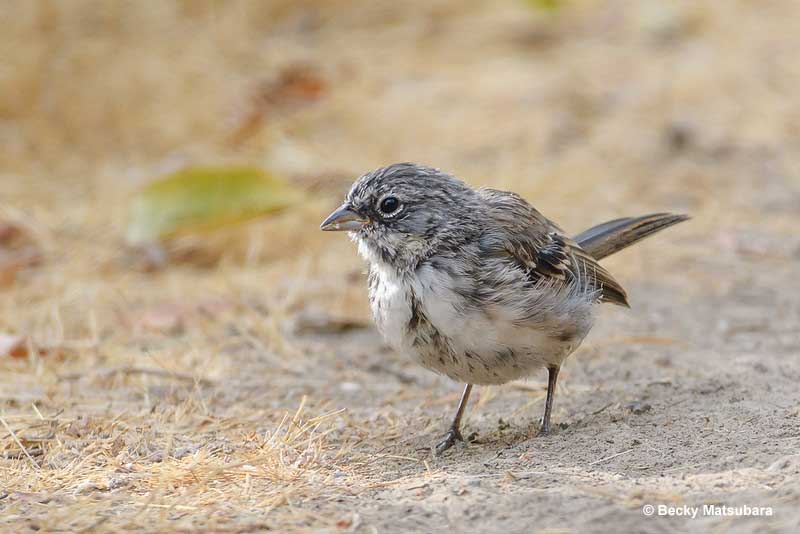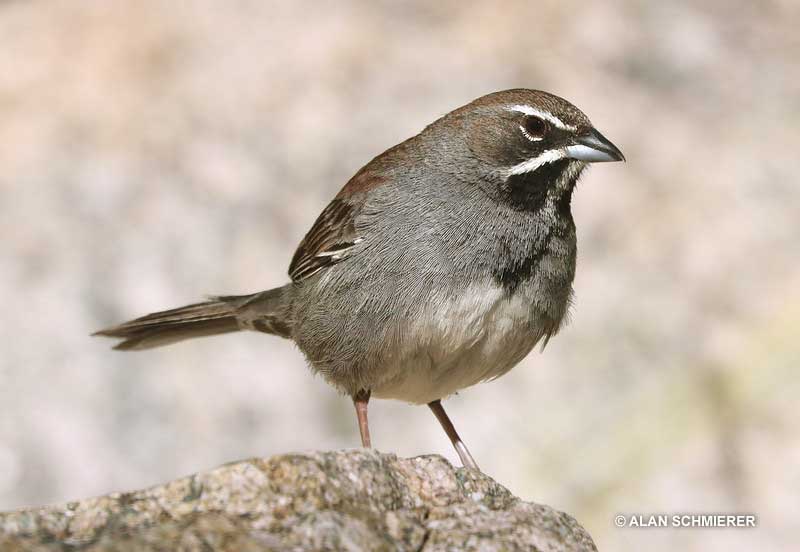
Sparrows are such cute little birds! They come to feeders, make happy chirping sounds, and most are pretty easy to see.
However, sparrows can also be a challenge to identify. There are so many types of sparrows; many look similar, and some only live in small, localized areas!
How can you tell all those sparrows apart? Where do sparrows live, and how can you see uncommon sparrow species?
How Many Types of Sparrows Are There In North America?
North America has a lot of sparrow species, more than most people realize. An incredible 37 species of sparrows have occurred in Canada and the USA. That doesn’t even include other members of the sparrow family; Lark Buntings, towhees, and juncos!
Two of our sparrows are actually introduced species that belong to another avian family, the Old World Sparrows. These two bird species are the well-known House Sparrow and the local Eurasian Tree Sparrow.
Although they act a lot like the native North American sparrows, these birds are more related to sparrows that live in Europe, Asia, and especially, Africa. The Song Sparrow, Swamp Sparrow, White-throated Sparrow, and other sparrow species in the USA and Canada are native birds.
Many live in brushy habitats although a few occur in deserts, and some other sparrows are birds of marshes and grassland habitats. We detail most of these sparrow species below and also include key tips to help find and identify these special little birds!
House Sparrow
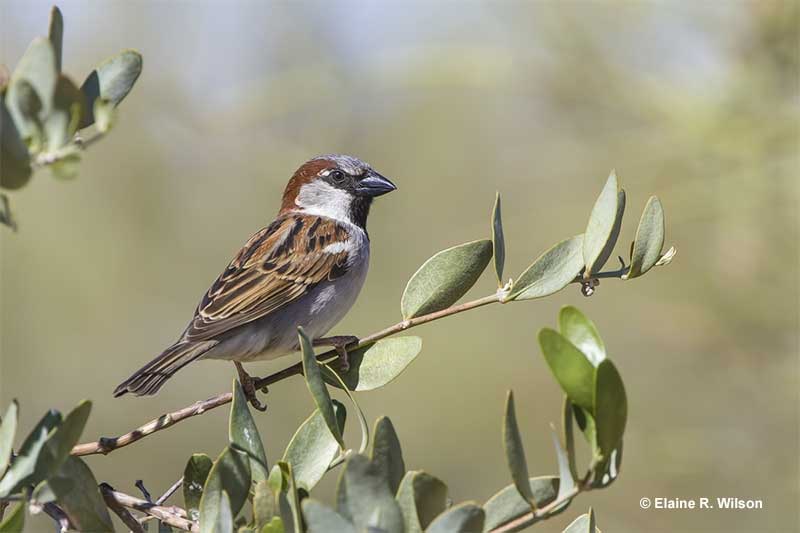
Scientific name: Passer domesticus
Size: 6.25 inches
Habitat: Farms, parks, and urban areas.
House Sparrows are the familiar sparrows that chirp and chatter from backyards and sidewalks. If you see a bunch of sparrows at your feeder, there’s a pretty good chance they are House Sparrows!
To make sure, take a good look at their heads. Males have black throats, a gray crown, and pale gray cheeks. If you see one with brown cheeks and a pinkish bill in the winter, take a closer look; that bird could be a Harriss’s Sparrow!
Female House Sparrows can resemble young winter White-crowned Sparrows but the female House Sparrows have a grayish crown.
House Sparrows can also be recognized by their easy-going behavior. Unlike other sparrows, these introduced birds are totally adapted to living near people. While various other sparrow species can hide in dense vegetation, House Sparrows pick seeds and bugs from lawns, streets, parking lots, and other open, urban spaces.
Eurasian Tree Sparrow
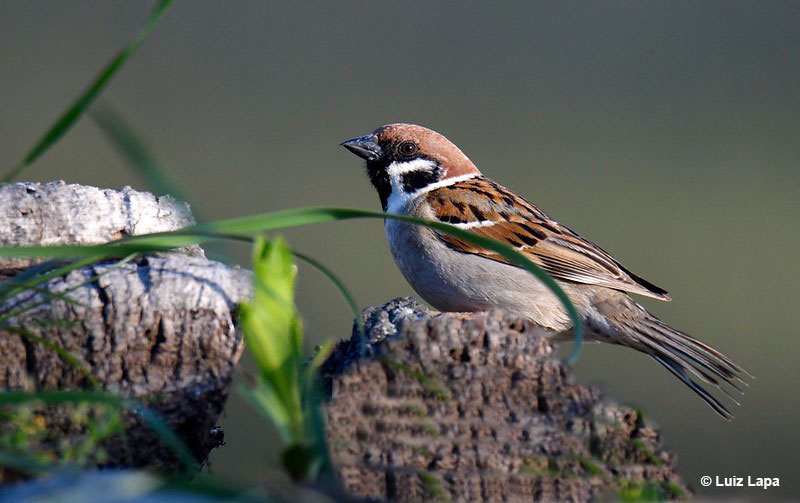
Scientific name: Passer montanus
Size: 6 inches
Habitat: Woodlots and farms, especially near wetlands.
This species is a common bird in Europe and much of Asia. Like the House Sparrow, it was introduced to North America but never became as successful as that common species.
Eurasian Tree Sparrows haven’t spread much further than the area where they were first introduced – Saint Louis. You can see them there as well as in some other nearby areas, including parts of Illinois.
They live in parks and similar habitats, especially near water.
These sparrows usually occur in chattering flocks and look a lot like a House Sparrow. However Eurasian Tree Sparrows are daintier, have browner flanks, a red-brown crown, and a prominent black mark on each side of their face.
This sparrow forages for seeds and bugs both on the ground and in vegetation. It also visits feeders and stays in the same area all year long.
American Tree Sparrow
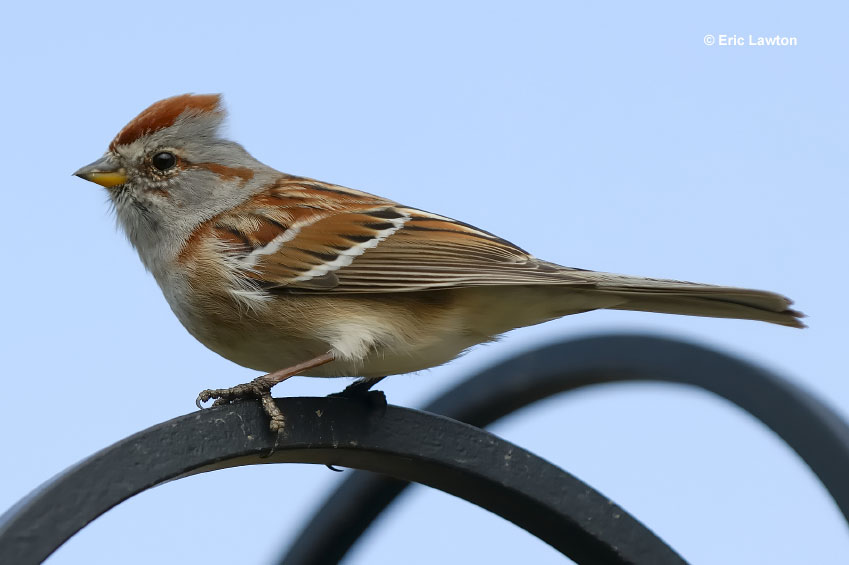
Scientific name: Spizelloides arborea
Size: 6.25 inches
Habitat: Brushy fields and open scrubby habitats with scattered trees.
American Tree Sparrows are slender sparrows with frosty gray tails and a “bicolored” beak that is dark above and yellowish below. They also have a red-brown line through their eyes, red-brown on their crown, and a narrow broken white eyering.
For anyone who lives outside of Alaska and northern Canada, American Tree Sparrows are classic winter birds. After breeding in far northern habitats, these pretty little sparrows fly south to southern Canada and the northern half of the USA.
Flocks can visit feeders but also forage for seeds in brushy fields and the undergrowth of open woodlands. Despite their name, these sparrows aren’t as arboreal as many other birds!
Although they will sing a pretty twinkling song while perched in a tree, they still do most of their foraging on the ground. Their bicolored beak, rusty crown, and dark spot on their plain grayish chest separates them from other sparrows.
Bachman’s Sparrow
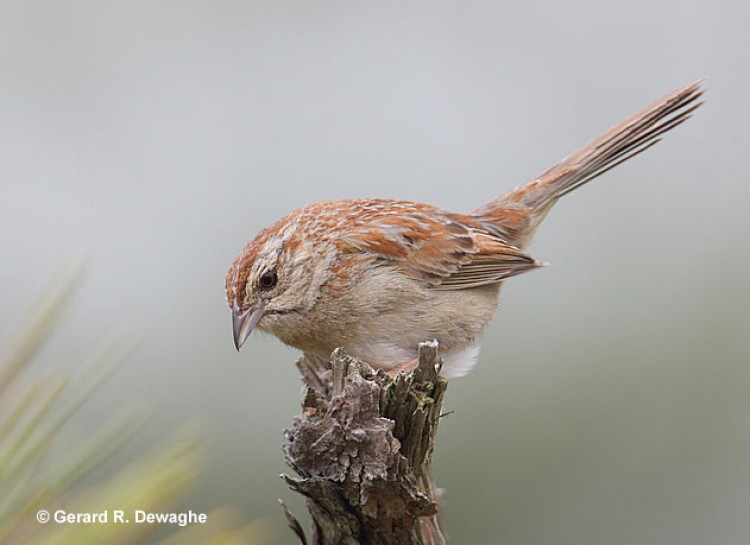
Scientific name: Peucaea aestivalis
Size: 6 inches
Habitat: Pine woodlands and other habitats with a dense, grassy understory.
The Bachman’s Sparrow might be a plain-looking sparrow but it’s a pretty special bird. This sparrow species only lives in brushy and dense grassy habitats in the southern USA. It’s especially fond of mature pine woodlands that are occasionally burned and maintained for the rare Red-cockaded Woodpecker.
However, even where the Bachman’s Sparrows occurs, it can be a really tough bird to see! Instead of foraging in the open and happily visiting feeders, these sparrows prefer hiding in low, dense vegetation.
With that in mind, one of the best ways to see one is to visit a good area for them in spring (check eBird), and listen for their sweet and simple song. It sounds like a high-pitched, buzzy trill followed by more musical trilled notes.
If you do see a Bachman’s Sparrow, you can recognize it by the bird’s plain underparts, lack of wing bars, rusty crown, and faint eyering.
Baird’s Sparrow
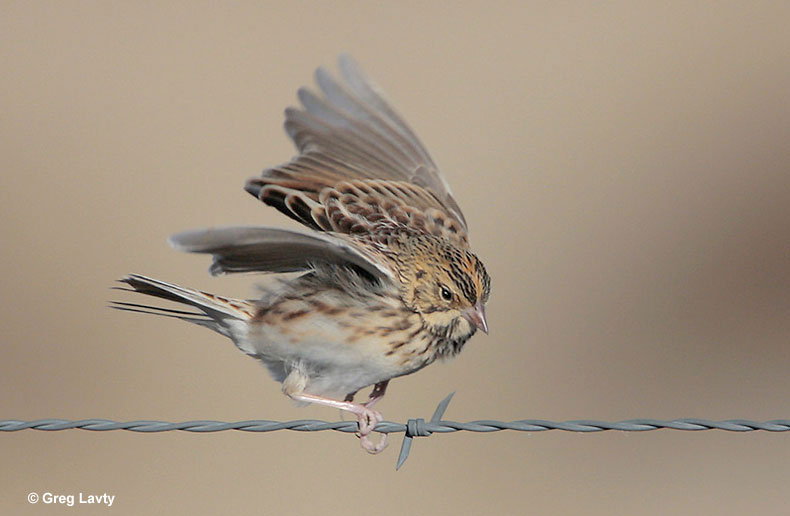
Scientific name: Centronyx bairdii
Size: 5.5 inches
Habitat: Prairie with shrubby plants.
The Baird’s Sparrow is another challenging sparrow to see. This small sparrow mostly breeds in wet prairies and marshes in south-central Canada, Montana, the Dakotas, and a few other nearby areas.
It’s a small, pale sparrow with a rather flat crown, and a few dark markings on each side of its buffy face. The Baird’s Sparrow also has white underparts with some sparse black streaks on its chest and flanks.
Baird’s Sparrows forage in low, dense vegetation for seeds and bugs, and rarely come into the open. You won’t see them at feeders but if you visit their breeding grounds in spring, you might find males singing their high-pitched song from the top of a prairie plant.
In winter, we can also see small numbers of Baird’s Sparrows flocking with other sparrow species in parts of southern Arizona and Texas. They prefer areas with dense grassland vegetation, especially ungrazed places.
Bell’s Sparrow
Scientific name: Artemisiospiza belli
Size: 6 inches
Habitat: Sage and other shrubby habitats.
Look for the Bell’s Sparrow in old field guides and you might not find it! This species used to be “lumped” with the Sage Sparrow until ornithologists separated them into two species.
The Bell’s Sparrow is a handsome bird with white eyering and a moustache that contrasts with its dark gray head. It also has white spots just above its dark beak, plain gray-brown wings, and a blackish tail. This bird has white underparts with some streaks on brownish sides, and a dark spot in the middle of its chest.
These sparrows forage for seeds, arthropods, and berries both on the ground and in low vegetation. Since the Bell’s Sparrow prefers to stay in dense cover, it can take some patience to see one!
Listening for its chipping call notes and chattering busy song can help locate these special little birds. They only occur in California, adjacent parts of Nevada and Arizona, and in Baja California.
Black-chinned Sparrow
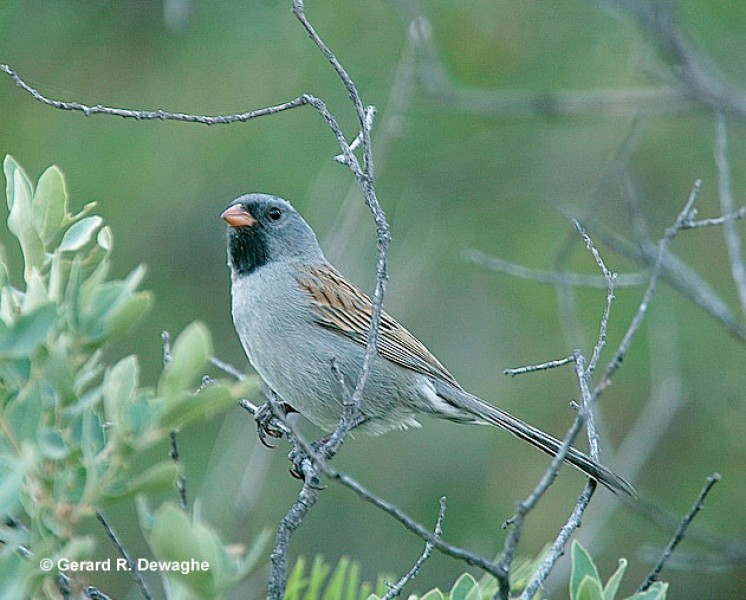
Scientific name: Spizella atrogularis
Size: 5.75 inches
Habitat: Arid shrublands, especially on rocky slopes.
Black-chinned Sparrows are slender, junco-like sparrows of the American Southwest. Unlike most other sparrows species, Black-chinneds are fairly easy to identify. They have mostly gray plumage with a brown back and wings, a black throat, and a pinkish beak.
These long-tailed sparrows forage for bugs and seeds on the ground, and in the low scattered bushes typical of their habitat. They are especially common in canyons and on rocky slopes with lots of scattered pinyon trees and shrubs.
This semi-open habitat also makes it pretty easy to see Black-chinned Sparrows. Watch for single birds or pairs foraging on the ground and perching on top of bushes. Males in particular, like to perch right on top of a shrub and sing to their heart’s content. They have a sweet, whistled trill that speeds up.
Although these sparrows look a bit like juncos, it doesn’t have white in its tail and has completely gray underparts.
Black-throated Sparrow
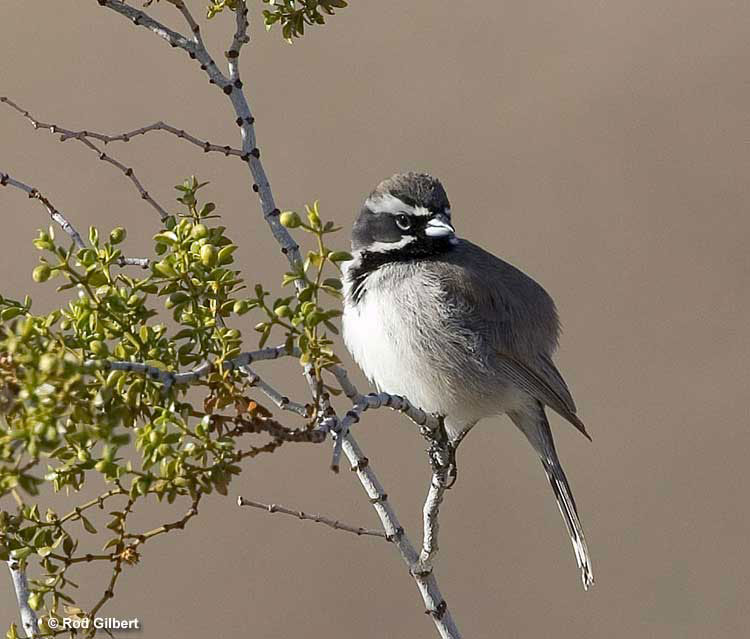
Scientific name: Amphispiza bilineata
Size: 5.5 inches
Habitat: Deserts and other arid habitats with scattered shrubs and short trees.
Black-throated Sparrows are boldly patterned birds of deserts and other arid habitats. True to their name, they have a prominent black throat along with a white moustache mark, and a white eyebrow.
The rest of their plumage is mostly gray and pale gray-brown. No other sparrow species has such an extensive black throat, and they are pretty easy to identify in their desert habitat. This pretty little bird is also easy to see!
Go birding in deserts within their range and you have a pretty good chance of espying Black-throated Sparrows. They usually occur in pairs that forage on the ground for seeds and bugs. Males also like to perch on a cactus or other prominent plant and sing their brief but cheerful song.
Their song sounds a bit like a Song Sparrow but is shorter and simpler.
Botteri’s Sparrow
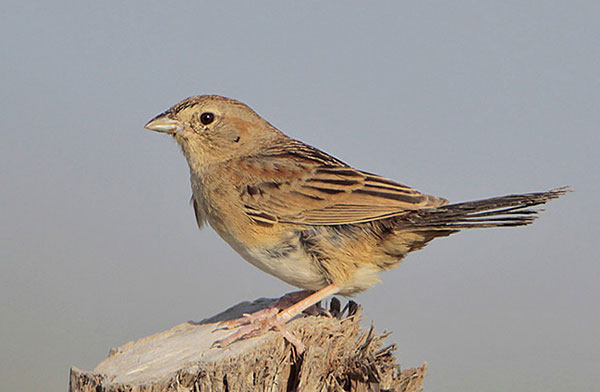
Scientific name: Peucaea botterii
Size: 6 inches
Habitat: Arid and tropical grasslands.
The Botteri’s Sparrow is a bird that mostly lives in Mexico. In the USA, this sparrow with plain plumage only ranges into southeastern Arizona and the southern tip of Texas. It’s a pretty nondescript little bird with plain, unstreaked underparts, plain, grayish wings, a streaked back, and a rather plain face.
These sparrows also have a fairly large beak and a dark crown. It can be really difficult to separate it from the similar Cassin’s Sparrow but the Botteri’s has a streaked back while the Cassin’s has more of a scalloped pattern on its back.
The Botteri’s Sparrow also has a plainer face, more uniform throat, and plainer wings. Most of all, Botteri’s Sparrows have a song that starts with some chipping notes and then speeds up to end with a trill.
Watch for these local birds singing and foraging on the ground in tall grassland habitats.
Brewer’s Sparrow
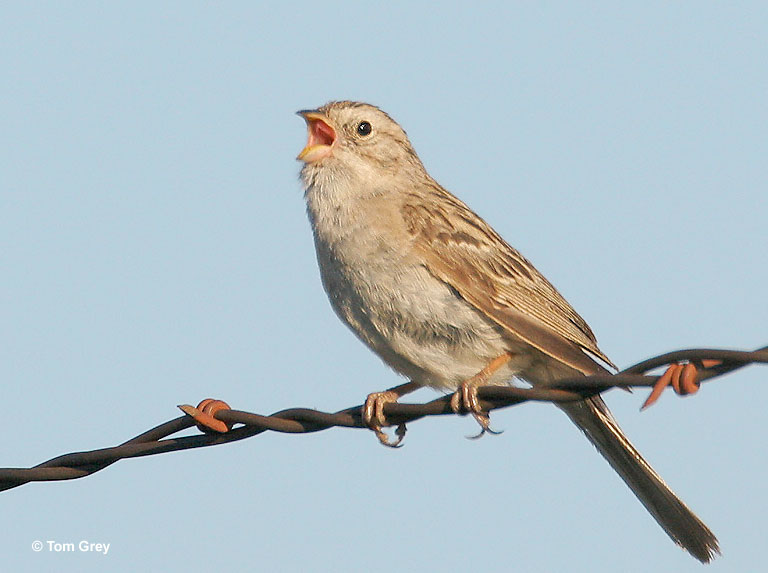
Scientific name: Spizella breweri
Size: 5.5 inches
Habitat: Shrubland habitats, especially with lots of sage.
The Brewer’s Sparrow is a small, slight sparrow with a longish, slightly forked tail. It’s also one of the plainest birds in North America, even for a sparrow!
These little sparrows don’t have any bold field marks but you can still identify them with a good look. Watch for their very plain appearance with unstreaked underparts, pale eyering, small beak, and finely streaked crown.
Brewer’s Sparrows are birds of sagebrush and other dry shrubby areas in western North America. In summer, they occur in pairs but, in migration and winter, form flocks with each other and other sparrow species.
Like most sparrows, Brewer’s Sparrows forage on the ground for small seeds and insects. In their typical range, this species is fairly easy to see. Watch for small, plain birds flitting on and near the ground and perching on sagebrush and other bushes.
Cassin’s Sparrow
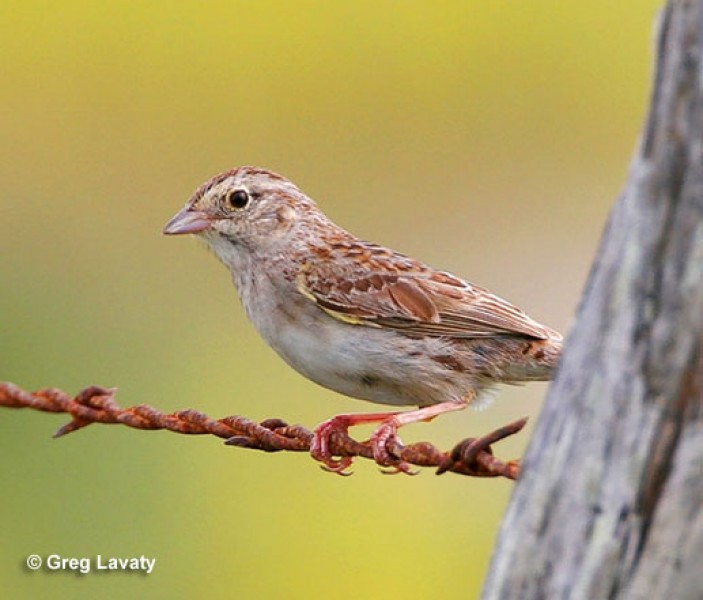
Scientific name: Peucaea cassinii
Size: 6 inches
Habitat: Arid grasslands with scattered shrubs and cacti.
The Cassin’s Sparrow is another plain sparrow of arid habitats. The best way to identify this bird is to look for it in its habitat, and focus in on its head, back, and wings.
This species often shows a hint of a crest, has a pale eyering, small beak, and a pale throat bordered by a faint dark line on each side. Its back is more scalloped than streaked, and it has some white edging on the feathers of its wings.
These sparrows are birds of arid grasslands and semi-deserts, especially shortgrass prairie with scattered cholla cactus and other arid shrubs.
In spring, males fly into the air and sing a song that starts with high-pitched trills and ends with short, sweet notes. On their breeding grounds, Cassins’s Sparrows occur in pairs that forage for seeds and bugs on and near the ground. In winter, they can flock with other sparrows.
Chipping Sparrow
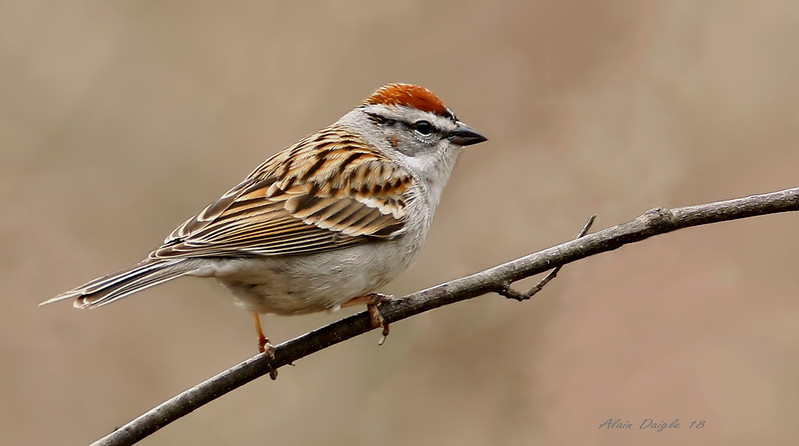
Scientific name: Spizella passerina
Size: 5.5 inches
Habitat: Parks and other areas open, grassy areas with scattered conifers.
The Chipping Sparrow is one of the more common and familiar sparrow species. This small and slender sparrow likes to live in parks and park-like habitats where scattered conifers dot extensive lawns. Take a walk in places like this and you’ll probably see a few of these handsome little birds!
In spring and summer, Chipping Sparrows have a rufous crown, white eyebrow, and a black line through their eyes. The rest of their plumage is gray with a white throat, brown streaked back, and wings with two pale wing bars.
Pairs of Chipping Sparrows forage for seeds and small insects on the ground, and males occasionally sing their long, trilled song from the top of a pine.
In winter, Chipping Sparrows are more confusing but can still be separated from the Clay-colored Sparrow and similar birds by their patterned face and gray rump.
At this time of year, they form flocks in open grassy places.
Clay-colored Sparrow
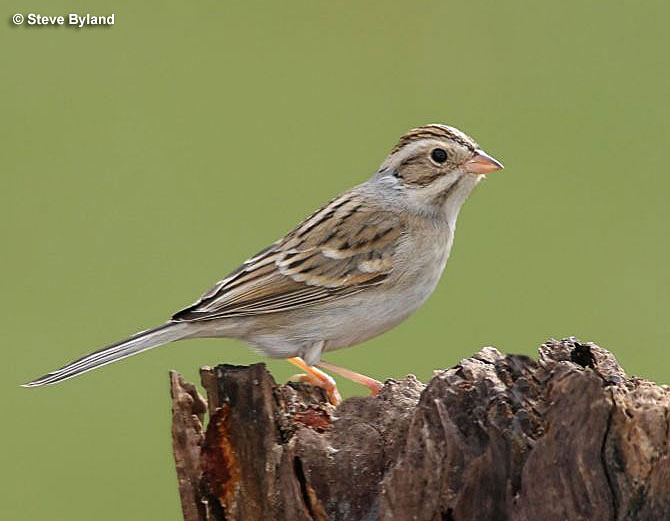
Scientific name: Spizella pallida
Size: 5.5 inches
Habitat: Grasslands and shrubby habitats with scattered trees.
Clay-colored Sparrows are plain, pale brown sparrows with a longish tail and a small beak. They can resemble other small sparrows but with a close look, you can identify them! This slender sparrow has a slightly forked tail, and has unstreaked underparts that are more buff-colored than gray.
They also have a pale brown rump, a pale, short moustache mark, grayish nape, and rather plain, buffy face that lacks an eyering. In spring and summer, this species usually occurs in pairs that forage for small seeds and insects on the ground.
They prefer grassy areas with scattered bushes and trees where males perch and sing. Unlike the similar Chipping Sparrow, Clay-colored Sparrows have a high-pitched, brief and buzzy trilled song.
In summer, this bird mostly occurs in the north-central USA and central Canada. Clay-colored Sparrows mostly winter in Mexico where they forage in flocks with each other and other sparrow species.
Field Sparrow
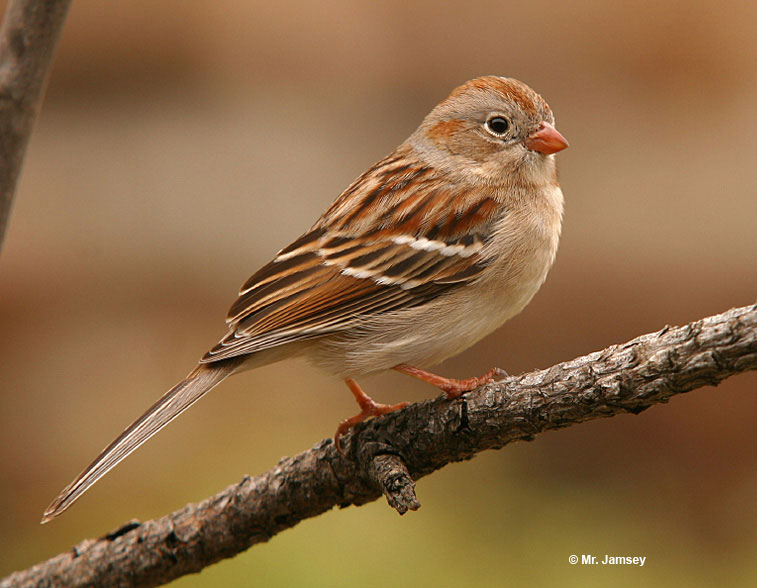
Scientific name: Spizella pusilla
Size: 5.75 inches
Habitat: Old fields and similar habitats.
Field Sparrows are slender, plain birds with a red-brown crown, pinkish beak, and a white eyering on a plain gray face. The rest of their head and underparts can be gray or buff, and they have a streaked, brown back, and two pale wing bars on brown wings.
The best way to identify Field Sparrows is by noticing their pinkish beak, white eyering, and unstreaked underparts. In summer, their trilled “bouncing ball” song is a common sound in this bird’s favorite habitat; old, weedy fields.
This sparrow species is common in overgrown fields where they forage for insects and seeds. You might see them on the ground but the easiest way to see a Field Sparrow is by listening for and finding a singing male. When singing, they like to perch on top of a tall stalk that peaks out of the grass.
In winter, Field Sparrows form small flocks in old fields and other brushy habitats.
Five-striped Sparrow
Scientific name: Amphispizopsis quinquestriata
Size: 6 inches
Habitat: Arid scrubby vegetation, often in canyons.
Five-striped Sparrows are distinctive, fancy sparrows with longish, rounded tails, and a unique head pattern. They have a dark head with a narrow white eyebrow, black and white moustache marks, and a narrow white throat.
The rest of their plumage is dark gray with plain, dark brown upperparts, and they have a black spot on their chest. These field marks make Five-striped Sparrows pretty easy to identify. However, they aren’t the easiest of birds to see!
In the USA, these sparrows only occur in a few isolated canyons in southeastern Arizona, close to the Mexican border. However, since those sites are well known, you can visit them and see these fancy little birds.
Five-striped Sparrows forage on the ground and in low vegetation for caterpillars and other insects. They also eat seeds but not as much as other sparrows. These distinctive birds also occur as pairs or in small flocks.
Fox Sparrow

Scientific name: Passerella iliaca
Size: 7 inches
Habitat: Scrubby woodlands, and thick, brushy fields.
The Fox Sparrow is a big, chunky sparrow of second growth and woodland thickets. This handsome bird also has a few different plumages. In the east, they have “fox red” highlights with some gray on their head and back.
Although their plumage pattern looks a bit like a Song Sparrow, Fox Sparrows are much bigger and much more red-brown. In the west, Fox Sparrows are darker, much grayer birds that have very little red-brown coloration!
These birds are best identified by their large size, gray or dark brown heads, and heavily streaked or spotted chest and flanks.
Fox Sparrows forage for insects and seeds on and near the ground. They prefer thick undergrowth and thickets, especially in wet areas like streams, bogs, and swamps.
In spring and summer, you might hear their brief but loud song. It starts with two or three notes and ends with a few hurried whistles and trills.
Golden-crowned Sparrow
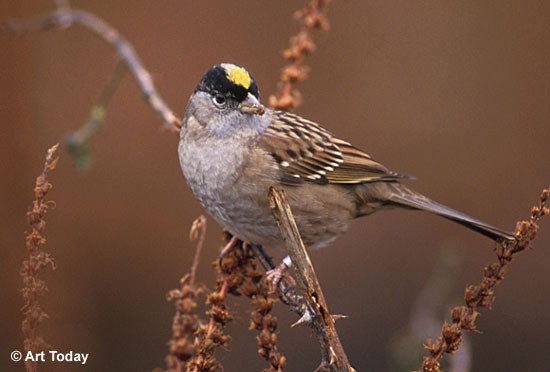
Scientific name: Zonotrichia atricapilla
Size: 7.25 inches
Habitat: Scrubby tundra, thickets, and other brushy habitats.
Golden-crowned Sparrows are big gray and brown sparrows with two pale wing bars, and a gray, bicolored beak. Depending on the time of year, they have black above their eyes, and, most of all, have a yellow crown.
Although young birds don’t have as much yellow as adults, they always show some yellow on their crown. This is the best field mark to separate this species from the White-crowned Sparrow and other large sparrow species.
Golden-crowned Sparrows breed in northern thickets and other shrubby habitats and winter in similar brushy habitats from British Columbia to California. They often occur in small flocks that forage for insects, buds, plant shoots, seeds, and small fruits.
In spring and summer, males sing a pretty, brief whistled song that descends in pitch. During the Gold Rush era in the Yukon and Alaska, miners sometimes described this bird’s song as sadly saying, “No gold here…”.
Grasshopper Sparrow
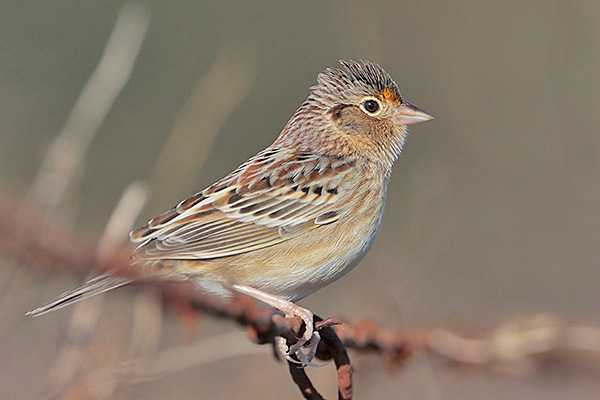
Photograph © Greg Lavaty.
Scientific name: Ammodramus savannarum
Size: 5 inches
Habitat: Various grassland and prairie habitats.
Grasshopper Sparrows are small, plain sparrows with a distinctive flat head and rather short tail. They have plain, buffy underparts, a rather large beak for their size, and a white eyering. They also have streaks and spotting on their upperparts, and a white line on the center of their crown.
The best way to identify Grasshopper Sparrows is by noticing their shape, plain, unstreaked underparts, and white eyering. These little birds live in grasslands with some other short woody plants.
They can be inconspicuous but often perch on the top of weed stalks. Grasshopper Sparrows also forage on the ground and in low bushes for seeds and insects. One of the ways to find them is to watch for the small birds on the ground and listen for their high-pitched ticking calls.
If you can hear high-pitched sounds, listening for the male’s insect-like buzzy song is another good way to locate one.
Harris’s Sparrow
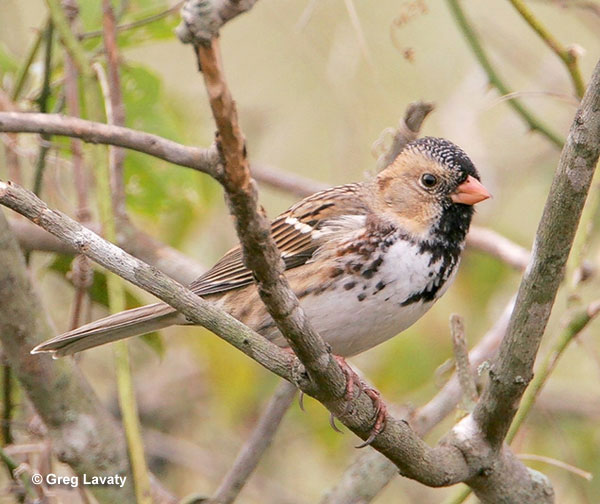
Scientific name: Zonotrichia querula
Size: 7.5 inches
Habitat: Tundra with some forest in the summer, hedgerows and thickets in the winter.
The Harris’s Sparrow is a big, boldly plumaged sparrow that breeds in remote areas in northern Canada. Most birders see them as they migrate to and winter in the central USA from Nebraska to Texas.
In spring, these big sparrows are gray and brown with a pink beak and black on their throat, face, and crown. In winter, they look similar but have more brown on their head, some white on their throat, and whiter underparts. However, Harriss’s Sparrows always have pink bills and this is one of the best ways to identify them.
In winter, flocks of this big sparrow frequent hedgerows and other brushy habitats, especially along streams and rivers. Like most sparrows, they forage for a variety of insects, seeds, and berries.
In spring, you might also hear their pretty song; three clear whistled notes on the same pitch.
Henslow’s Sparrow
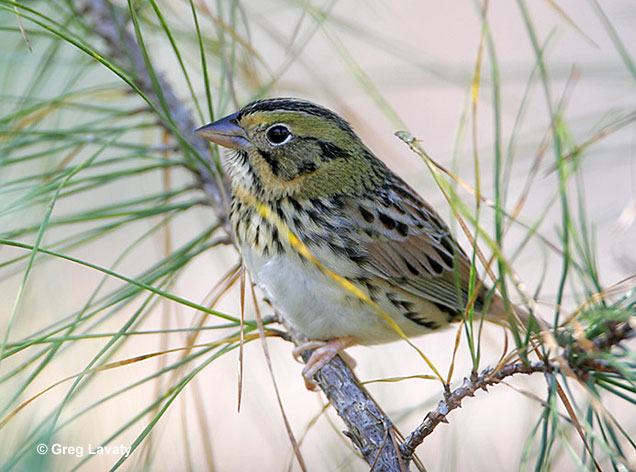
Scientific name: Centronyx henslowii
Size: 5 inches
Habitat: Wet prairies, meadows, and various other grassland habitats.
The Henslow’s Sparrow is a small and inconspicuous sparrow of thick wet meadows, hay fields, and dense wet prairies. In winter, they also live in dense grassy areas in the southeastern USA. Since it likes dense, wet vegetation, this bird can be hard to see! However, if you know where to look for it and what they sound like, you can find them.
In spring and summer, male Henslow’s Sparrows often sing from perches on top of their dense grassy habitats. Listen for an insect-like, easily overlooked, “Tsi-lick!” and you might see one!
This small sparrow species has a flat head and short tail, and can be recognized by its olive and buff head with white eyering, fine streaks on buff chest and flanks, and red-brown on its wings.
Henslow’s Sparrows forage for insects and seeds in low, dense vegetation. They don’t usually forage in the open but sometimes flush from the vegetation.
Lark Sparrow
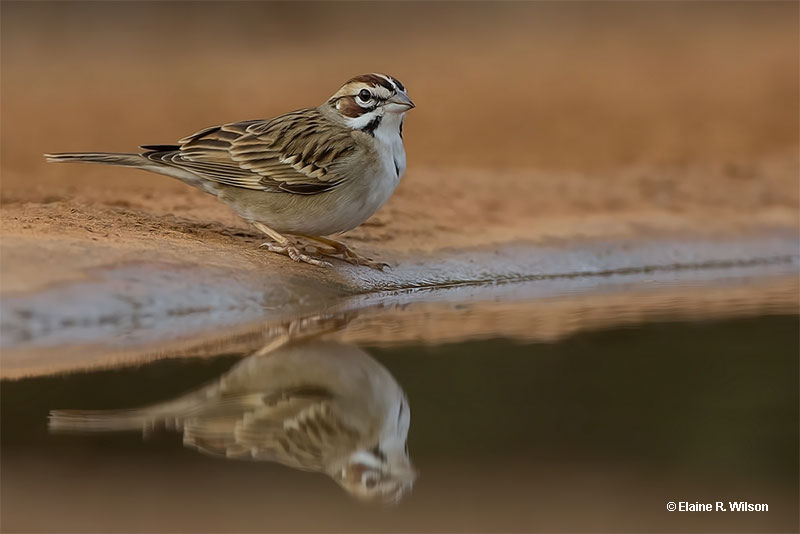
Scientific name: Chondestes grammacus
Size: 6.5 inches
Habitat: A variety of parklike habitats with grassy areas and scattered trees.
Lark Sparrows are fairly big sparrows with pretty, bold plumage. Unlike any other sparrow in North America, they have red-brown, black, and white markings on their heads. This head pattern makes them much easier to identify than other sparrow species, even for young birds.
This species also has a black mark on its plain chest, a lot of white in its rounded tail, and plain wings without wing bars.
Lark Sparrows live in open areas with sparse grass and scattered trees and bushes. They can be pretty common in much of their range, especially parts of Texas and western North America. Although they often occur as pairs in spring and summer, for most of the year, Lark Sparrows flock together.
Like most sparrows, they forage on the ground for seeds and insects. There are many winters in parts of the southern USA, but large numbers also winter in Mexico.
Le Conte’s Sparrow
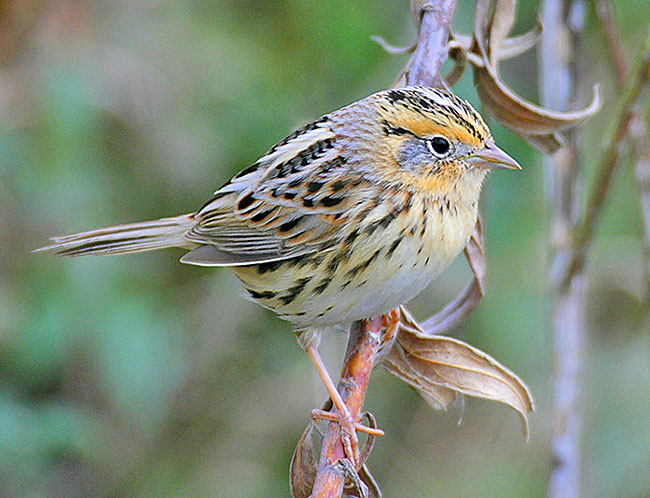
Scientific name: Ammospiza leconteii
Size: 5 inches
Habitat: Open, marshy meadows, sedge marshes, and wet fields with dense vegetation.
The Le Conte’s Sparrow is a small pale sparrow that breeds in remote parts of Canada and the north-central USA, and winters in the southeastern USA. This little bird breeds in dense sedge marshes and other similar habitats, and spends the winter in rice fields and other dense, wet vegetation.
No matter where it occurs, the dense habitat of the Le Conte’s Sparrow makes it a hard bird to see! This species prefers to stay under cover and rarely comes into the open. However, in spring and summer, males can sing their high-pitched, buzzy song from the top of the vegetation.
Le Conte’s Sparrows have short, rounded tails, a flat head, and a smallish beak. They have a white line on their crown and fine streaks on their buff chest and flanks. This species also has a gray spot on the side of its buff face, and shows more white in its wings than the Grasshopper Sparrow.
Lincoln’s Sparrow
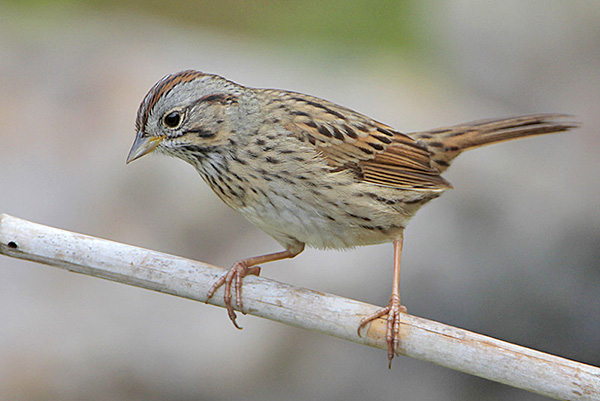
Photograph © Greg Lavaty.
Scientific name: Melospiza lincolnii
Size: 5.75 inches
Habitat: Bogs, wet, shrubby areas, thick, wet second growth.
The Lincoln’s Sparrow is a small, warblerish sparrow with a buffy eyering. It looks a lot like the Song Sparrow and some other species but has finer streaks on its buff chest and flanks.
Lincoln’s Sparrows also have a finer beak than the Song Sparrow, and a buffier moustache mark. These sparrows are fairly common birds of wet send growth, especially in wet thickets associated with wetland habitats.
Although most breed in remote areas of Canada, Alaska, and the Rocky Mountains, Lincoln’s Sparrows are pretty easy to see during migration and winter. They also prefer the same type of low, dense vegetation at that time of year and forage for insects and other bits of food.
This species doesn’t usually occur in flocks and are typically seen on their own. On their breeding grounds, males often sing but in migration and winter, Lincoln’s Sparrows give ticking calls from low, dense vegetation.
Nelson’s Sparrow
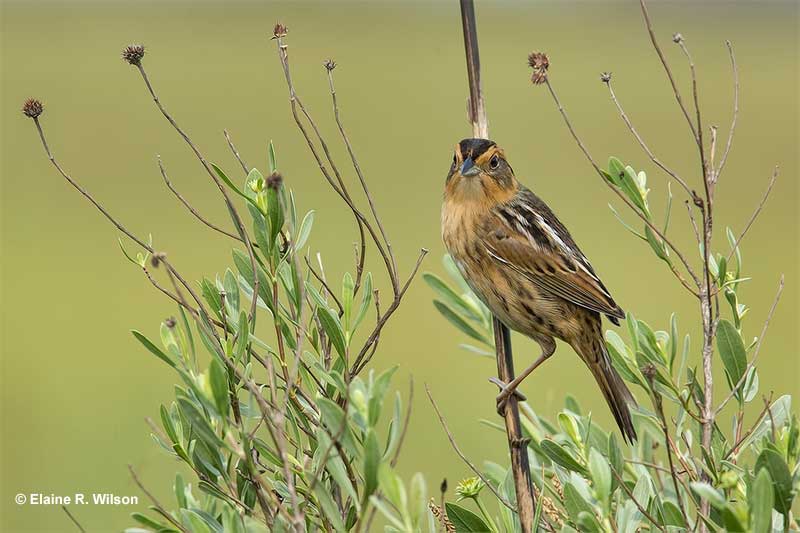
Scientific name: Ammospiza nelsoni
Size: 5 inches
Habitat: Marshes and wet grasslands.
The Nelson’s Sparrow is a small sparrow with a short tail and flat head. This pretty little bird has a rich buff and gray head with a dark gray crown. It also has some blurry streaks on its orange-buff chest and flanks, and red-brown wings.
This species has some pale streaks on its back, a rather fine beak, and breeds in northern marshes. Like other sparrows that live in marshy habitats, the Nelson’s Sparrow can be a challenging bird to see.
However, if you visit their breeding grounds and scan the top of their marshy habitat, you might find a singing male perched on top of the vegetation. As with other reclusive birds, you might also get lucky and see one at migration hotspots.
In winter, Nelson’s Sparrows hide in coastal marshes and rice fields. No matter where they occur, this little sparrow forages for insects and small seeds on and near the ground in dense vegetation.
Olive Sparrow
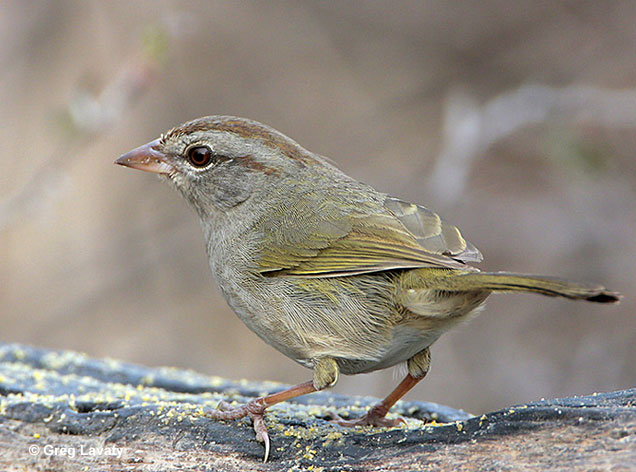
Scientific name: Arremonops rufivirgatus
Size: 6.25 inches
Habitat: Subtropical woodlands.
Olive Sparrows are tropical birds that barely range into the southern tip of Texas. Birders often visit this part of the USA to see this and species like the Altamira Oriole, Green Jay, and other common Mexican birds.
Luckily, this special little bird is also easy to identify. The Olive Sparrow has a plain and distinctive appearance that sets it apart from other sparrows and small birds. It doesn’t have any streaking, is pale gray and buff with an olive back, has a white eyering, and dull brown stripes on its head.
Olive Sparrows are pretty easy to see as they hop and forage for bugs and seeds on the ground. Pairs scratch and search in the leaf litter for their food while making high-pitched call notes. They also sing a high-pitched chipping song that starts slow and then speeds to become a trill.
Rufous-crowned Sparrow
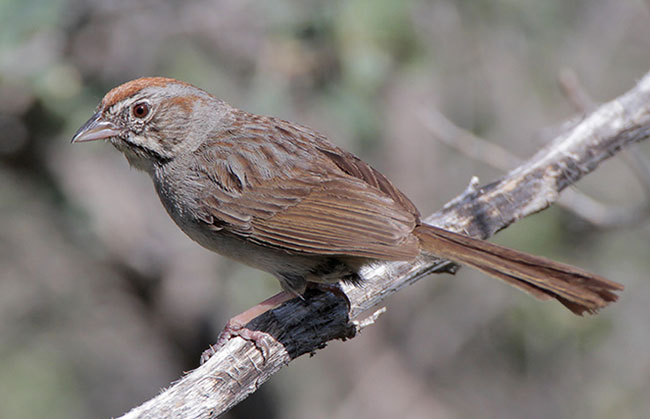
Scientific name: Aimophila ruficeps
Size: 6 inches
Habitat: Grassy habitats with shrubby areas and open woodlands on rocky slopes.
The Rufous-crowned Sparrow is a fair-sized sparrow species that lives in rocky canyons and dry hillsides with scattered bushes and vegetation. This sparrow might look like some other sparrow species but is actually more closely related to the towhees.
These types of sparrows are mostly gray and brown with red-brown on its crown and as a line going back from its eyes. It also has a dark gray beak, a prominent white eyering, and a short white moustache bordered with a black line.
Rufous-crowned Sparrows also have a pale buff vent and don’t have any streaking on their underparts. These smart-looking sparrows forage for seeds and insects on and near the ground. In general, since they live in open, rocky areas, Rufous-crowned Sparrows are pretty easy to see.
Unlike other sparrows, they typically occur in pairs and don’t form flocks. Males sing a brief and hurried, chattering song.
Rufous-winged Sparrow
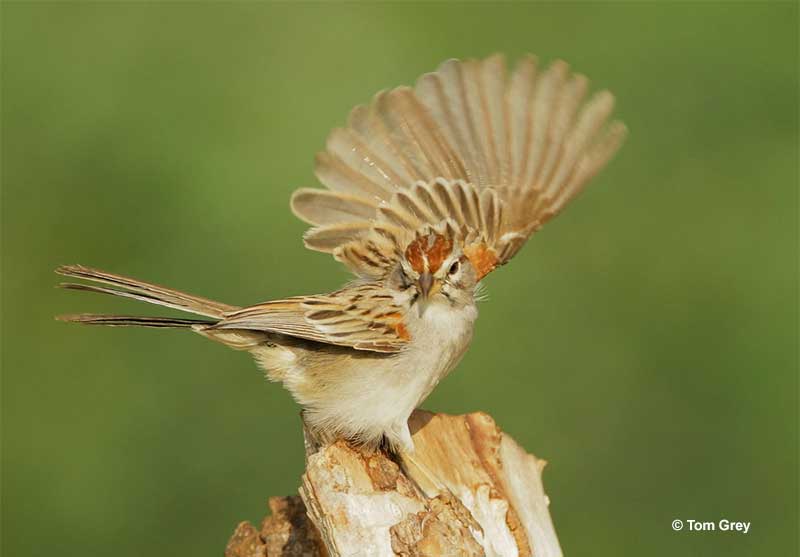
Scientific name: Peucaea carpalis
Size: 5.75 inches
Habitat: Desert grasslands and some scrubby vegetation.
Rufous-winged Sparrows are fairly large sparrows with plain gray and buff underparts, and a stout pale yellowish beak. Although they do have red-brown shoulders, this field mark can be pretty hard to see.
A better way to identify them is by focusing on the bird’s head. This sparrow has a red-brown line going back from each eye, red-brown on the top of its head, and a pale, broken eyering. Most of all, Rufous-winged Sparrows have two short black mustache marks.
This bird is a local species that only occurs in desert grasslands with scattered thorny bushes. It often occurs in riparian zones and in the USA, we can only see it in southern Arizona. Luckily, where it does occur, the Rufous-winged Sparrow isn’t that tough to see. Males often sing their plain chippering song from the top of a bush.
Pairs also calls as they forage for insects and seeds on and near the ground.
Sagebrush Sparrow
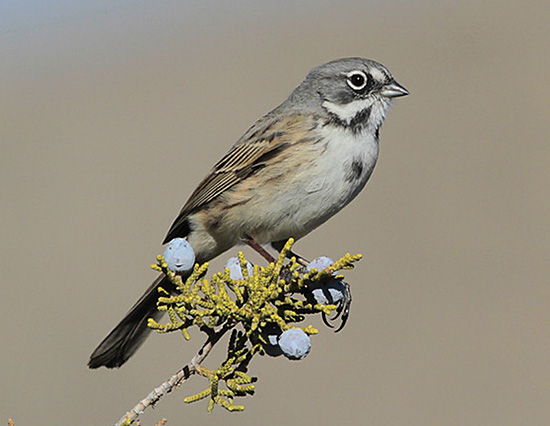
Scientific name: Artemisiospiza nevadensis
Size: 6 inches
Habitat: Sagebrush habitats.
The Sagebrush Sparrow used to be known as the “Sage Sparrow” but was eventually split into two species; the Sagebrush Sparrow and the Bell’s Sparrow.
The Sagebrush Sparrow is an easily recognizable sparrow with a white eyering and moustache on a gray head. It also has white spots above its dark beak, gray-brown wings with a hint of wing bars, and a blackish tail with white edges.
This bird species also has white underparts with some streaks on its brownish sides, and a dark spot in the middle of its chest.
Sagebrush Sparrows feed on insects, seeds, and berries on and near the ground. Just like their name says, this species is strongly associated with sagebrush habitats. In fact, it rarely occurs anywhere else!
They can be tough to see in this dense habitat but with patience, you might find a male Sagebrush Sparrow singing from the top of a bush.
Saltmarsh Sparrow
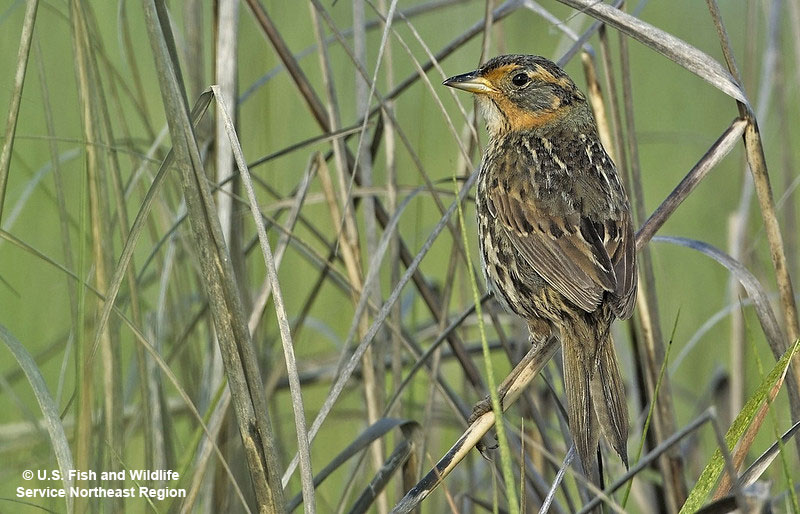
Scientific name: Ammospiza caudacuta
Size: 5.25 inches
Habitat: Tidal saltmarshes.
The Saltmarsh Sparrow is an endangered species that only lives in salt marsh habitats in the eastern USA. This small sparrow has a short, spiky tail, and a rather flat head. It used to be lumped with the Nelson’s Sparrow and both species were known as the “Sharp-tailed Sparrow”.
However, on account of their plumage and breeding habitat differences, they were eventually split into two species.
The Saltmarsh Sparrow can be recognized by its buffy eyebrow on its gray and buff head, pale streaks on its back, and fine dark streaking on its pale buff chest and flanks.
This species forages on the muddy ground for insects, other small creatures, and seeds. It usually occurs in pairs that nest in tidal salt marshes and their nests can be quite susceptible to flooding. If their nests are destroyed by water, Saltmarsh Sparrows quickly renest in another spot.
Savannah Sparrow
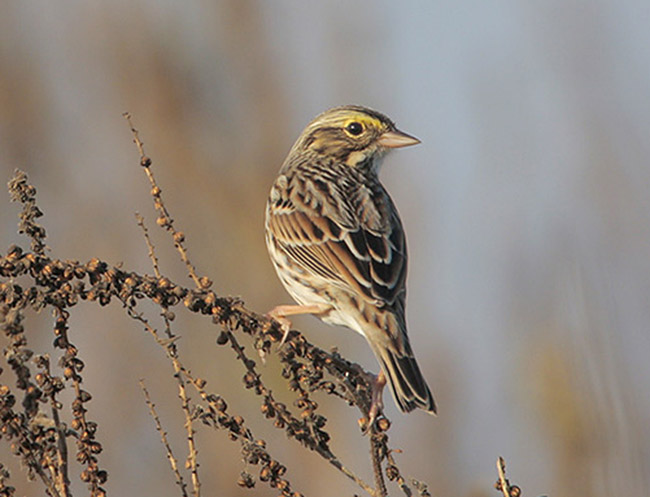
Scientific name: Passerculus sandwichensis
Size: 5.5 inches
Habitat: Open grassy fields, pastures, golf courses, and other open grassy habitats.
Savannah Sparrows are small, streaked sparrows that live in a variety of open, grassy areas. Although they look a lot like other sparrows, we can often recognize them by fine, dark streaking on their chest and flanks, short, forked tail, and yellowish mark in front of their eyes.
This species also has a dark line going back from their eyes. Savannah Sparrows are pretty common and easy to see in most parts of their range. Watch for them as they forage on the ground and perch in the grass.
These little sparrows feed on small insects and seeds, and can form small flocks. However, in spring and summer, they are often seen on their own. Another way to locate this bird is by listening for a singing male. They sing over and over, a high-pitched, easily overlooked song that starts with a few notes and then has two buzzy trills, the second one lower pitched than the first.
Seaside Sparrow
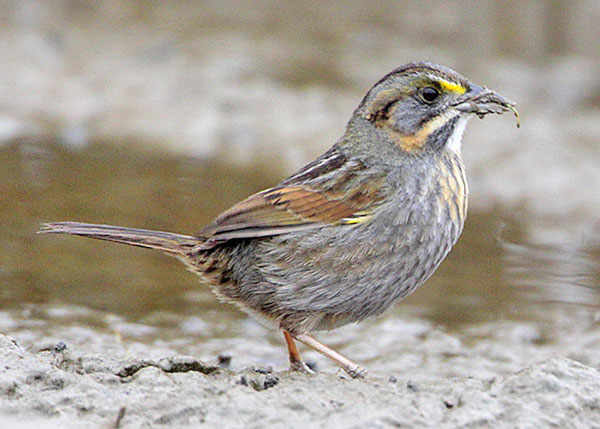
Photograph © Greg Lavaty
Scientific name: Ammospiza maritima
Size: 6 inches
Habitat: Saltmarshes.
Seaside Sparrows are distinctive, dark gray sparrows with rather short rounded tails, biggish heads, and rather long, dark beaks. These little coastal birds are dingy dark gray with a white throat, red-brown wings, and a yellow spot in front of each eye.
The rare Cape Sable subspecies in southern Florida has white underparts with thick dark streaks. Seaside Sparrows only live in coastal marshes and build their nests in vegetation high enough to avoid flood waters.
This dark sparrow occurs in pairs or small groups, and forages on and near the muddy ground. They hop around and pick arthropods and other small creatures from the ground and vegetation, often in slightly open areas.
With that in mind, one good way to see this aquatic songbird is to watch for them on the muddy ground at the edge of salt marsh vegetation. With luck, you may see some although you might also spot Seaside Sparrows in the marsh vegetation too.
Song Sparrow
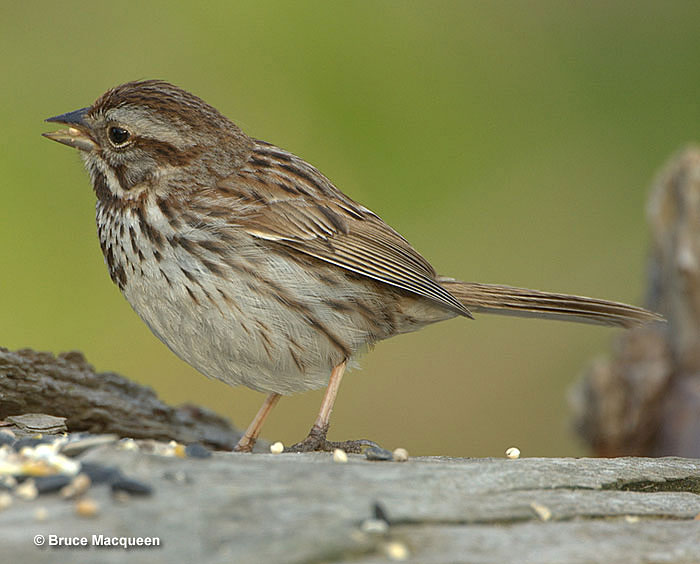
Scientific name: Melospiza melodia
Size: 6.25 inches
Habitat: Bushes and shrubby habitats in parks, near wetlands, and other places.
Song Sparrows are one of the more common sparrow species. These streaked brown birds occur in brushy habitats in most of North America, even in many city parks. Although they might not perch right on your feeder, Song Sparrows can visit to pick up seed that falls to the ground.
With streaked brown plumage, these types of sparrows are “average-looking” sparrows. Its plumage also varies a bit in different parts of Canada and the USA. However, we can always recognize them by their heavy streaking on their chest and flanks, thick dark mustache marks, and a prominent dark spot on their chest.
Song Sparrows frequent brushy areas and second growth, especially thickets next to rivers and other wetlands. They usually occur in pairs that forage for insects and seeds, both on the ground and in low vegetation.
Just like their name says, this bird does sing quite often. The male says, “Just just drink your teeea!”.
Swamp Sparrow
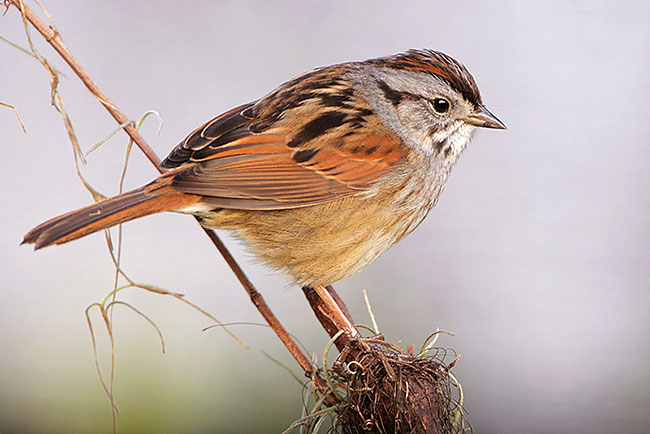
Scientific name: Melospiza georgiana
Size: 5.75 inches
Habitat: A wide variety of wetland and marsh habitats.
Swamp Sparrows are small common sparrows of marshy wetland habitats. They resemble several other sparrows but are separated by their plain underparts with rich brown flanks, and a red-brown crown.
Swamp Sparrows also have plain red-brown wings, and a pale, broken eyering. These little birds eat more insects than most other sparrows and forage for them on the ground and in low vegetation.
They often catch bugs by wading in and near the water! The sparrows pick them from under the water, the surface, and also low marsh vegetation. In fall and winter, Swamp Sparrows also eat a lot of seeds.
This species usually occurs as pairs but several can live in the same marsh. In winter, they hide in low, dense vegetation. Although their behavior can make Swamp Sparrows a bit of a challenge to watch, with some patience, they aren’t that tough to see.
Listen for the male’s two second trilling song.
Vesper Sparrow
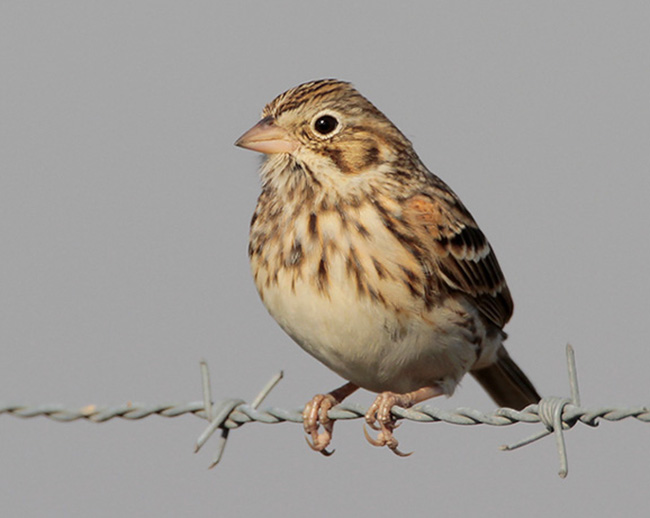
Scientific name: Pooecetes gramineus
Size: 6.25 inches
Habitat: Dry and open habitats with patches of vegetation.
The Vesper Sparrow is a fairly large, pale gray-brown sparrow with a longish tail. We can separate it from other, similar streaked sparrows by focusing on its head and tail. Vesper Sparrows have fine streaks on their crown, a white eyering, and dark rectangular patch on the lower side of their face,
They also have prominent white outer tail feathers and a white undertail, and a smallish, pale pinkish beak. With a good look, we might also see this bird’s rusty shoulder patch.
Vesper Sparrows occur in pairs that forage for insects and seeds on the ground and in low vegetation. They often use their feet to scratch the dry ground and stir up bits of food.
This species prefers open dry habitats with some vegetation like farm fields and similar places. If you are watching a bare field and see a sparrow with white in its tail fly up to a tree, it might be a Vesper Sparrow.
White-crowned Sparrow
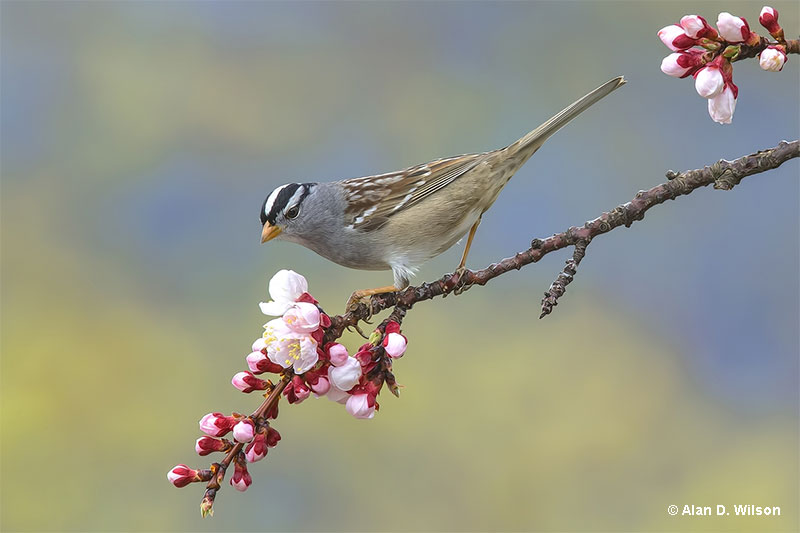
Scientific name: Zonotrichia leucophrys
Size: 7 inches
Habitat: Grassy areas with bare ground and some dense conifers in the summer, and various brushy habitats in the winter.
The White-crowned Sparrow is a big gray and brown sparrow with a prominent black and white crown. It can resemble Golden-crowned and White-throated Sparrows but doesn’t have any white on its throat and has a pale pinkish, orange, or yellowish beak.
White-crowned Sparrows breed in shrubby habitats in the far north and in western North America. After breeding, flocks move into brushy woodlands in many parts of the western, central, and southern USA.
These big sparrows forage on the ground and in bushes for lots of seeds, grain, flower buds, berries, and some insects. They can also visit feeders but much prefer to pick up seeds from the ground.
This prominent sparrow species is fairly easy to see. On its breeding grounds, they hop on and near the ground and sing from the top of bushes. In the winter, flocks can often be located by listening for their distinctive “peek” calls.
White-throated Sparrow
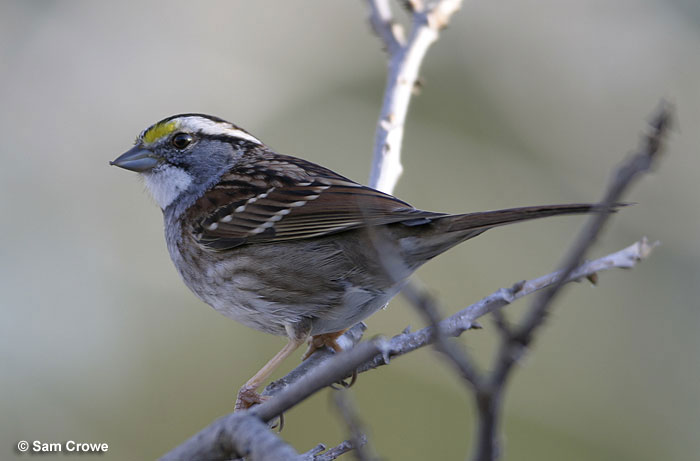
Scientific name: Zonotrichia albicollis
Size: 6.75 inches
Habitat: Woodlands with a brushy understory.
The White-throated Sparrow is a common, large gray and brown sparrow of eastern North America. Some also winter on the Pacific coast but most occur east of the Rockies. They are also easy to identify!
This species has a prominent white throat and can have either black and white or tan and brown stripes on its head. It also has a grayish beak and a yellow spot in front of each eye.
Pairs of White-throated Sparrows breed in mixed forests of Canada and parts of the northern USA. They forage on the ground and in low vegetation for bugs, berries, and seeds. In winter, flocks mostly eat seeds that they find in woodlands and brushy vegetation.
One of the ways to find these birds is by listening for them scratching in leaf litter. White-throated Sparrows use both of their feet to toss leaves and find seeds and other bits of food.
Sparrows In The U.S: FAQ’s
How many sparrow species live in the United States?
In total, 36 species species live in the United States.
What is the difference between Old World sparrows and New World sparrows?
The difference between Old World Sparrows and New World Sparrows is that they are two distinct, different bird families. Although members of these families look somewhat similar, they are not closely related to each other.
What is the most common sparrow in the world?
The most common sparrow in the world is the House Sparrow. This species has an estimated population of well over one billion and is one of the most abundant birds in the world.
How similar are finches, juncos, and towhees to sparrows?
Finches, juncos, and towhees are similar to sparrows in terms of their conical, seed-eating beaks and general size and shape. However, finches belong to a different bird family, and juncos and towhees tend to be larger and have more colorful or bolder plumage.
Why are some sparrow species endangered or near-threatened?
Some sparrow species are endangered or near-threatened because they live in highly threatened habitats like marshes and grasslands.


